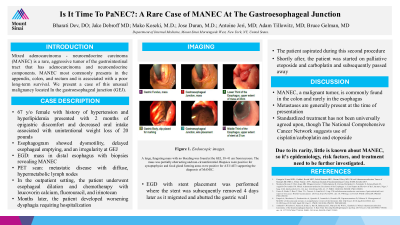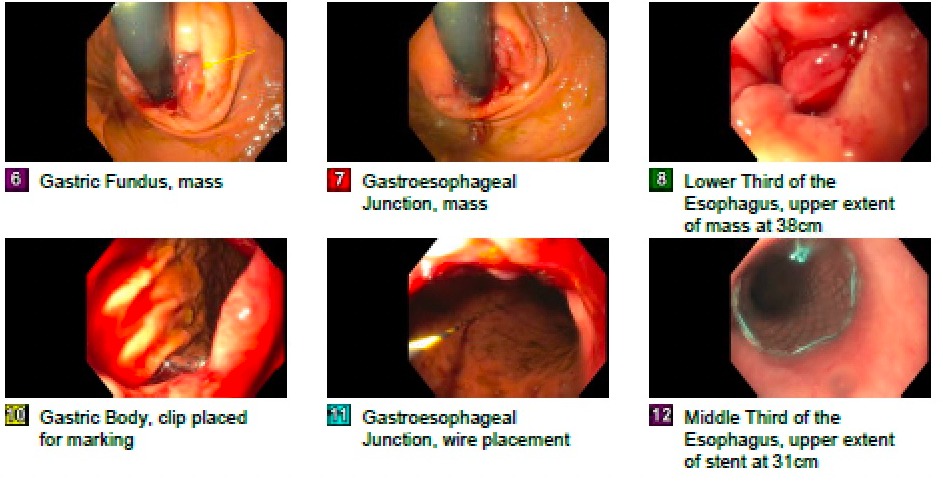Monday Poster Session
Category: Esophagus
P2281 - Is It Time to Panic?: A Rare Case of MANEC at the Gastroesophageal Junction
Monday, October 28, 2024
10:30 AM - 4:00 PM ET
Location: Exhibit Hall E

Has Audio

Bharati Dev, DO
Icahn School of Medicine at Mount Sinai Morningside/West
New York, NY
Presenting Author(s)
Bharati Dev, DO1, Jake DeBroff, MD2, Mako Koseki, MD2, Jose Duran, MD2, Antoine Jeri-Yabar, MD3, Adam Tillowitz, MD1, Bruce P. Gelman, MD4
1Icahn School of Medicine at Mount Sinai Morningside/West, New York, NY; 2Mount Sinai Beth Israel, Icahn School of Medicine at Mount Sinai, New York, NY; 3Icahn School of Medicine at Mount Sinai Morningside/West, Manhattan, NY; 4Mount Sinai West, Icahn School of Medicine at Mount Sinai, New York, NY
Introduction: Mixed adenocarcinoma-neuroendocrine carcinoma (MANEC) is a rare, aggressive tumor of the gastrointestinal tract that has adenocarcinoma and neuroendocrine components. MANEC presents in the appendix, colon, and rectum and is associated with poor long-term survival. We present a case of this unusual malignancy found at the gastroesophageal junction (GEJ).
Case Description/Methods: A 67-year-old female with history of hypertension and hyperlipidemia presented with 2 months of epigastric discomfort and decreased oral intake, associated with an unintentional weight loss of 20 pounds.
An esophagram showed dysmotility, delayed esophageal emptying, and an irregularity at the GEJ. Esophagogastroduodenoscopy (EGD) demonstrated a mass in the distal esophagus with biopsies revealing MANEC. A PET scan highlighted metastatic disease with diffuse hypermetabolic lymph nodes. In the outpatient setting, the patient underwent esophageal dilation and chemotherapy with leucovorin calcium, fluorouracil, and irinotecan (FOLFIRI).
Months later, the patient developed worsening dysphagia requiring hospitalization. An EGD with stent placement was performed, showing worsened obstruction at the GEJ with similar pathology. The stent was removed 4 days later, as it migrated and abutted the gastric wall. The patient unfortunately had an aspiration event, requiring oxygen support. She was started on palliative etoposide and carboplatin and subsequently passed away.
Discussion: We present a case of an esophageal MANEC, which is a rare malignant tumor most commonly found in the colon. Metastases are generally present at the time of presentation. Standardized treatment has not been universally agreed upon. The National Comprehensive Cancer Network suggests the use of cisplatin/carboplatin and etoposide. Due to its rarity, little is known about MANEC so its epidemiology, risk factors and treatment need to be further investigated.

Disclosures:
Bharati Dev, DO1, Jake DeBroff, MD2, Mako Koseki, MD2, Jose Duran, MD2, Antoine Jeri-Yabar, MD3, Adam Tillowitz, MD1, Bruce P. Gelman, MD4. P2281 - Is It Time to Panic?: A Rare Case of MANEC at the Gastroesophageal Junction, ACG 2024 Annual Scientific Meeting Abstracts. Philadelphia, PA: American College of Gastroenterology.
1Icahn School of Medicine at Mount Sinai Morningside/West, New York, NY; 2Mount Sinai Beth Israel, Icahn School of Medicine at Mount Sinai, New York, NY; 3Icahn School of Medicine at Mount Sinai Morningside/West, Manhattan, NY; 4Mount Sinai West, Icahn School of Medicine at Mount Sinai, New York, NY
Introduction: Mixed adenocarcinoma-neuroendocrine carcinoma (MANEC) is a rare, aggressive tumor of the gastrointestinal tract that has adenocarcinoma and neuroendocrine components. MANEC presents in the appendix, colon, and rectum and is associated with poor long-term survival. We present a case of this unusual malignancy found at the gastroesophageal junction (GEJ).
Case Description/Methods: A 67-year-old female with history of hypertension and hyperlipidemia presented with 2 months of epigastric discomfort and decreased oral intake, associated with an unintentional weight loss of 20 pounds.
An esophagram showed dysmotility, delayed esophageal emptying, and an irregularity at the GEJ. Esophagogastroduodenoscopy (EGD) demonstrated a mass in the distal esophagus with biopsies revealing MANEC. A PET scan highlighted metastatic disease with diffuse hypermetabolic lymph nodes. In the outpatient setting, the patient underwent esophageal dilation and chemotherapy with leucovorin calcium, fluorouracil, and irinotecan (FOLFIRI).
Months later, the patient developed worsening dysphagia requiring hospitalization. An EGD with stent placement was performed, showing worsened obstruction at the GEJ with similar pathology. The stent was removed 4 days later, as it migrated and abutted the gastric wall. The patient unfortunately had an aspiration event, requiring oxygen support. She was started on palliative etoposide and carboplatin and subsequently passed away.
Discussion: We present a case of an esophageal MANEC, which is a rare malignant tumor most commonly found in the colon. Metastases are generally present at the time of presentation. Standardized treatment has not been universally agreed upon. The National Comprehensive Cancer Network suggests the use of cisplatin/carboplatin and etoposide. Due to its rarity, little is known about MANEC so its epidemiology, risk factors and treatment need to be further investigated.

Figure: A large, fungating mass with no bleeding was found at the GEJ, 38 – 41 cm from the incisors. The mass was partially obstructing and non-circumferential. A stent was placed under fluoroscopic and endoscopic guidance. Biopsies were positive for synaptophysin and focal gland forming areas were positive for AE1/AE3 supporting a diagnosis of MANEC. Immunohistochemistry testing for MLH1, MSH2, MSH6, and PMS2 were negative.
Disclosures:
Bharati Dev indicated no relevant financial relationships.
Jake DeBroff indicated no relevant financial relationships.
Mako Koseki indicated no relevant financial relationships.
Jose Duran indicated no relevant financial relationships.
Antoine Jeri-Yabar indicated no relevant financial relationships.
Adam Tillowitz indicated no relevant financial relationships.
Bruce Gelman indicated no relevant financial relationships.
Bharati Dev, DO1, Jake DeBroff, MD2, Mako Koseki, MD2, Jose Duran, MD2, Antoine Jeri-Yabar, MD3, Adam Tillowitz, MD1, Bruce P. Gelman, MD4. P2281 - Is It Time to Panic?: A Rare Case of MANEC at the Gastroesophageal Junction, ACG 2024 Annual Scientific Meeting Abstracts. Philadelphia, PA: American College of Gastroenterology.
